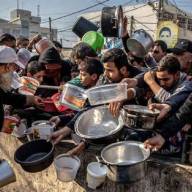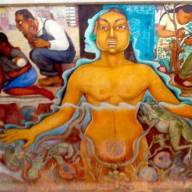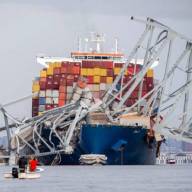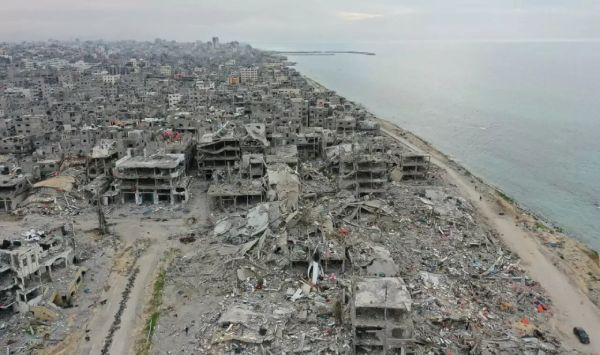The past five months have been clarifying. What was supposed to be hidden has been thrust into the light. What was supposed to be obscured has come sharply into focus.
Liberal democracy is not what it seems.
It has always defined itself in contrast to what it says it is not. Where other regimes are savage, it is humanitarian. Where others are authoritarian, it is open and tolerant. Where others are criminal, it is law-abiding. When others are belligerent, it seeks peace. Or so the manuals of liberal democracy argue.
But how to keep the faith when the world’s leading liberal democracies – invariably referred to as “the West” – are complicit in the crime of crimes: genocide?
Not just law-breaking or a misdemeanour, but the extermination of a people. And not just quickly, before the mind has time to absorb and weigh the gravity and extent of the crime, but in slow motion, day after day, week after week, month after month.
What kind of system of values can allow for five months the crushing of children under rubble, the detonation of fragile bodies, the wasting away of babies, while still claiming to be humanitarian, tolerant, peace-seeking?
And not just allow all this, but actively assist in it. Supply the bombs that blow those children to pieces or bring houses down on them, and sever ties to the only aid agency that can hope to keep them alive.
The answer, it seems, is the West’s system of values.
The mask has not just slipped, it has been ripped off. What lies beneath is ugly indeed.
Depravity on show
They are given a name. It is Russia. It is Al Qaeda, and Islamic State. It is China. And right now, it is Hamas.
There must be an enemy. But this time, the West’s own evil is so hard to disguise, and the enemy so paltry – a few thousand fighters underground inside a prison besieged for 17 years – that the asymmetry is difficult to ignore. The excuses are hard to swallow.
Is Hamas really so evil, so cunning, so much of a threat that it requires mass slaughter? Does the West really believe that the attack of 7 October warrants the killing, maiming and orphaning of many, many tens of thousands of children as a response?
To stamp out such thoughts, Western elites have had to do two things. First, they have tried to persuade their publics that the acts they collude in are not as bad as they look. And then that the evil perpetrated by the enemy is so exceptional, so unconscionable it justifies a response in kind.
Which is exactly the role Western media has played over the past five months.
Starved by Israel
To understand how Western publics are being manipulated, just look to the coverage – especially from those outlets most closely aligned not with the right but with supposedly liberal values.
How have the media dealt with the 2.3 million Palestinians of Gaza being gradually starved to death by an Israeli aid blockade, an action that lacks any obvious military purpose beyond inflicting a savage vengeance on Palestinian civilians? After all, Hamas fighters will outlast the young, the sick and the elderly in any mediaeval-style, attritional war denying Gaza food, water and medicines.
A headline in the New York Times, for example, told readers last month, “Starvation is stalking Gaza’s children”, as if this were a famine in Africa – a natural disaster, or an unexpected humanitarian catastrophe – rather than a policy declared in advance and carefully orchestrated by Israel’s top echelons.
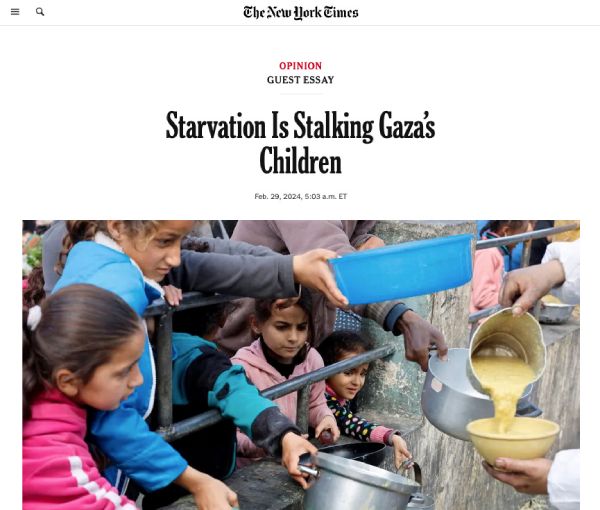
The Financial Times offered the same perverse framing: “Starvation stalks children of northern Gaza”.
But starvation is not an actor in Gaza. Israel is. Israel is choosing to starve Gaza’s children. It renews that policy each day afresh, fully aware of the terrible price being inflicted on the population.
As the head of Medical Aid for Palestinians warned of developments in Gaza: “Children are being starved at the fastest rate the world has ever seen.”
Last week Unicef, the United Nations children’s emergency fund, declared that a third of children aged under two in northern Gaza were acutely malnourished. Its executive director, Catherine Russell, was clear: “An immediate humanitarian cease-fire continues to provide the only chance to save children's lives and end their suffering.”
Were it really starvation doing the stalking, rather than Israel imposing starvation, the West’s powerlessness would be more understandable. Which is what the media presumably want their readers to infer.
But the West isn’t powerless. It is enabling this crime against humanity – day after day, week after week – by refusing to exert its power to punish Israel, or even to threaten to punish it, for blocking aid.
Not only that, but the US and Europe have helped Israel starve Gaza’s children by denying funding to the UN refugee agency, UNRWA, the main humanitarian lifeline in the enclave.
All of this is obscured – meant to be obscured – by headlines that transfer the agency for starving children to an abstract noun rather than a country with a large, vengeful army.
Attack on aid convoy
Such misdirection is everywhere – and it is entirely intentional. It is a playbook being used by every single Western media outlet. It was all too visible when an aid convoy last month reached Gaza City, where levels of Israeli-induced famine are most extreme.
In what has come to be known by Palestinians as the “Flour Massacre”, Israel shot into large crowds desperately trying to get food parcels from a rare aid convoy to feed their starving families. More than 100 Palestinians were killed by the gunfire, or crushed by Israeli tanks or hit by trucks fleeing the scene. Many hundreds more were seriously wounded.
It was an Israeli war crime – shooting on civilians – that came on top of an Israeli crime against humanity – starving two million civilians to death.
The Israeli attack on those waiting for aid was not a one-off. It has been repeated several times, though you would barely know it, given the paucity of coverage.
The depravity of using aid convoys as traps to lure Palestinians to their deaths is almost too much to grasp.
But that is not the reason the headlines that greeted this horrifying incident so uniformly obscured or soft-soaped Israel’s crime.
For any journalist, the headline should have written itself: “Israel accused of killing over 100 as crowd waits for Gaza aid.” Or: “Israel fires into food aid crowd. Hundreds killed and injured”
But that would have accurately transferred agency to Israel – Gaza’s occupier for more than half a century, and its besieger for the last 17 years – in the deaths of those it has been occupying and besieging. Something inconceivable for the Western media.
So the focus had to be shifted elsewhere.
BBC contortions
The Guardian’s contortions were particularly spectacular: “Biden says Gaza food aid-related deaths complicate ceasefire talks”.
The massacre by Israel was disappeared as mysterious “food aid-related deaths”, which in turn became secondary to the Guardian’s focus on the diplomatic fallout.
Readers were steered by the headline into assuming that the true victims were not the hundreds of Palestinians killed and maimed by Israel but the Israeli hostages whose chances of being freed had been “complicated” by “food aid-related deaths”.
The headline on a BBC analysis of the same war crime – now reframed as an author-less “tragedy” – repeated the New York Times’ trick: “Aid convoy tragedy shows fear of starvation haunts Gaza”.
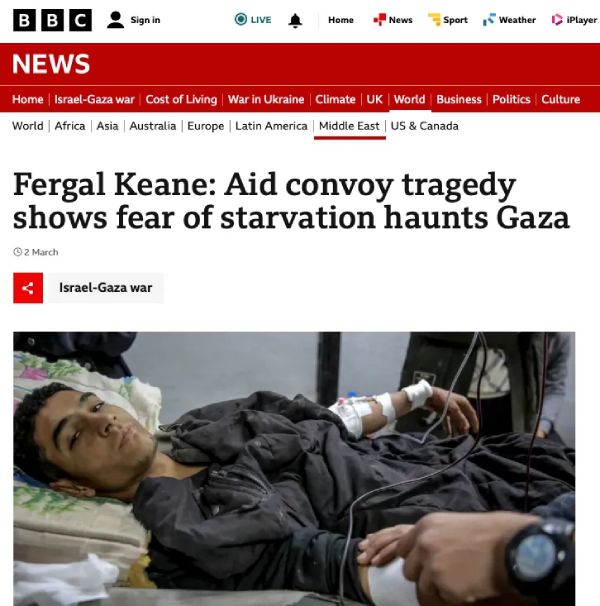
Another favourite manoeuvre, again pioneered by the Guardian, was to cloud responsibility for a clear-cut war crime. Its front-page headline read: “More than 100 Palestinians die in chaos surrounding Gaza aid convoy”.
Once again, Israel was removed from the crime scene. In fact, worse, the crime scene was removed too. Palestinians “died” apparently because of poor aid management. Maybe UNRWA was to blame.
Chaos and confusion became useful refrains for media outlets keener to shroud culpability. The Washington Post declared: “Chaotic aid delivery turns deadly as Israeli, Gazan officials trade blame”. CNN took the same line, downgrading a war crime to a “chaotic incident”.
But even these failings were better than the media’s rapidly waning interest as Israel’s massacres of Palestinians seeking aid became routine – and therefore harder to mystify.
A few days after the Flour Massacre, an Israeli air strike on an aid truck in Deir al-Balah killed at least nine Palestinians, while last week more than 20 hungry Palestinians were killed by Israeli helicopter gunfire as they waited for aid.
“Food aid-related” massacres – which had quickly become as normalised as Israel’s invasions of hospitals – no longer merited serious attention. A search suggests the BBC managed to avoid giving significant coverage to either incident online.
Food-drop theatrics
Meanwhile, the media has ably assisted Washington in its various deflections from the collaborative crime against humanity of Israel imposing a famine on Gaza compounded by the US and Europe de-funding UNRWA, the only agency that could mitigate that famine.
British and US broadcasters excitedly joined air crews as their militaries flew big-bellied planes over Gaza’s beaches, at great expense, to drop one-off ready-made meals to a few of the starving Palestinians below.
Given that many hundreds of truckloads of aid a day are needed just to stop Gaza sliding deeper into famine, the drops were no more than theatrics. Each delivered at best a solitary truckload of aid – and then only if the palettes didn’t end up falling into the sea, or killing the Palestinians they were meant to benefit.
The operation deserved little more than ridicule.
Instead, dramatic visuals of heroic airmen, interspersed with expressions of concern about the difficulties of addressing the “humanitarian crisis” in Gaza, usefully distracted viewers’ attention not only from the operations’ futility but from the fact that, were the West really determined to help, it could strong-arm Israel into letting in far more plentiful aid by land at a moment’s notice.
The media were equally swept up by the Biden administration’s second, even more outlandish scheme to help starving Palestinians. The US is to build a temporary floating pier off Gaza’s coast so that aid shipments can be delivered from Cyprus.
The plot holes were gaping. The pier will take two months or more to construct, when the aid is needed now. In Cyprus, as at the land crossings into Gaza, Israel will be in charge of inspections – the main cause of hold-ups.
And if the US now thinks Gaza needs a port, why not also get to work on a more permanent one?
The answer, of course, might remind audiences of the situation before 7 October, when Gaza was under a stifling 17-year siege by Israel – the context for Hamas’ attack that the Western media never quite finds the space to mention.
For decades, Israel has denied Gaza any connections to the outside world it cannot control, including preventing a sea port from being built and bombing the enclave’s only airport way back in 2001, shortly after it was opened.
And yet, at the same time, Israel’s insistence that it no longer occupies Gaza – just because it has done so at arm’s length since 2005 – is accepted unquestioningly in media coverage.
Again, the US has decisive leverage over Israel, its client state, should it decide to exercise it – not least billions in aid and the diplomatic veto it wields so regularly on Israel’s behalf.
The question that needs asking by the media on every piece about “starvation stalking Gaza” is why is the US not using that leverage.
In a typical breathless piece titled “How the US military plans to construct a pier and get food into Gaza”, the BBC ignored the big picture to drill down enthusiastically on the details of “huge logistical” and “security challenges” facing Biden’s project.
The article revisited precedents from disaster relief operations in Somalia and Haiti to the D-Day Normandy landings in the Second World War.
Credulous journalists
In support of these diversionary tactics, the media have also had to accentuate the atrocities of Hamas’ 7 October attack – and the need to condemn the group at every turn – to contrast those crimes from what might otherwise appear even worse atrocities committed by Israel on the Palestinians.
That has required an unusually large dose of credulousness from journalists who more usually present as hard-bitten sceptics.
Babies being beheaded, or put in ovens, or hung out on clothes lines. No invented outrage by Hamas has been too improbable to have been denied front-page treatment, only to be quietly dropped later when each has turned out to be just as fabricated as it should have sounded to any reporter familiar with the way propagandists exploit the fog of war.
Similarly, the entire Western press corps has studiously ignored months of Israeli media revelations that have gradually shifted responsibility for some of the the most gruesome incidents of 7 October – such as the burning of hundreds of bodies – off Hamas’ shoulders and on to Israel’s.
Though Western media outlets failed to note the significance of his remarks, Israeli spokesman Mark Regev admitted that Israel’s numbering of its dead from 7 October had to be reduced by 200 because many of the badly charred remains turned out to be Hamas fighters.
Testimonies from Israeli commanders and officials show that, blindsided by the Hamas attack, Israeli forces struck out wildly with tank shells and Hellfire missiles, incinerating Hamas fighters and their Israeli captives indiscriminately. The burnt cars piled up as a visual signifier of Hamas’ sadism are, in fact, evidence of, at best, Israel’s incompetence and, at worst, its savagery.
The secret military protocol that directed Israel’s scorched-earth policy on 7 October – the notorious Hannibal procedure to stop any Israeli being taken captive – appears not to have merited mention by either the Guardian or the BBC in their acres of 7 October coverage.
Despite their endless revisiting of the 7 October events, neither has seen fit to report on the growing demands from Israeli families for an investigation into whether their loved ones were killed under Israel’s Hannibal procedure.
Nor have either the BBC or the Guardian reported on the comments of the Israeli military’s ethics chief, Prof Asa Kasher, bewailing the army’s resort to the Hannibal procedure on 7 October as “horrifying” and “unlawful”.
Claims of bestiality
Instead, liberal Western media outlets have repeatedly revisited claims that they have seen evidence – evidence they seem unwilling to share – that Hamas ordered rape to be used systematically by its fighters as a weapon of war. The barely veiled implication is that such depths of depravity explain, and possibly justify, the scale and savagery of Israel’s response.
Note that this claim is quite different from the argument that there may have been instances of rape on 7 October.
That is for good reason: There are plenty of indications that Israeli soldiers regularly use rape and sexual violence against Palestinians. A UN report in February addressing allegations that Israeli solders and officials had weaponised sexual violence against Palestinian women and girls since 7 October elicited none of the headlines and outrage from the Western media directed at Hamas.
To make a plausible case that Hamas changed the rules of war that day, much greater deviance and sinfulness has been required. And the liberal Western media have willingly played their part by recycling claims of mass, systematic rape by Hamas, combined with lurid claims of necrophilic perversions – while suggesting anyone who asks for evidence is condoning such bestiality.
But the liberal media’s claims of Hamas “mass rapes” – initiated by an agenda-setting piece by the New York Times and closely echoed by the Guardian weeks later – have crumbled on closer inspection.
Independent outlets such as Mondoweiss, Electronic Intifada, the Grayzone and others have gradually pulled apart the Hamas mass rape narrative.
But perhaps most damaging of all has been an investigation by the Intercept that revealed it was senior Times editors who recruited a novice Israeli journalist – a former Israeli intelligence official with a history of supporting genocidal statements against the people of Gaza – to do the field work.
More shocking still, it was the paper’s editors who then pressured her to find the story. In violation of investigative norms, the narrative was reverse engineered: imposed from the top, not found through on-the-ground reporting.
‘Conspiracy of silence’
The New York Times’ story appeared in late December under the headline “‘Screams Without Words’: How Hamas Weaponized Sexual Violence on Oct. 7”. The Guardian’s follow-up in mid-January draws so closely on the Times’ reporting that the paper has been accused of plagiarism. Its headline was: “Evidence points to systematic use of rape and sexual violence by Hamas in 7 October attacks”.
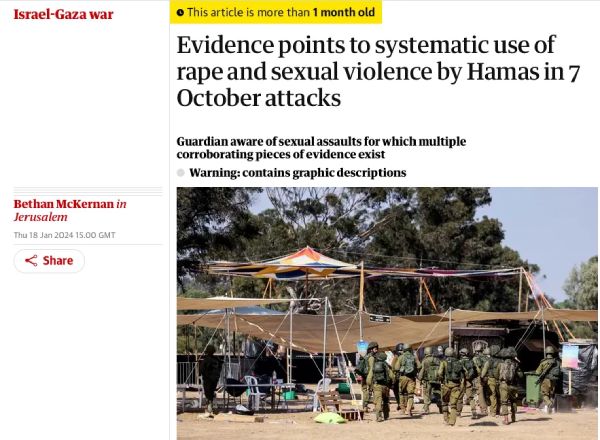
However, under questioning from the Intercept, a spokesperson for the New York Times readily walked back the paper’s original certainty, conceding instead that “there may have been systematic use of sexual assault.” [emphasis added] Even that appears too strong a conclusion.
Holes in the Times’ reporting quickly proved so glaring that its popular daily podcast pulled the plug on an episode dedicated to the story after its own fact check.
The rookie reporter assigned to the task, Anat Schwartz, has admitted that despite scouring the relevant institutions in Israel – from medical institutions to rape crisis centres – she found no one who could confirm a single example of sexual assault that day. She was also unable to find any forensic corroboration.
She later told a podcast with Israel’s Channel 12 that she viewed the lack of evidence to be proof of “a conspiracy of silence”.
Instead, Schwartz’s reporting relied on a handful of testimonies from witnesses whose other easily disprovable assertions should have called into question their credibility. Worse, their accounts of instances of sexual assault failed to tally with the known facts.
One paramedic, for example, claimed two teenage girls had been raped and killed at Kibbutz Nahal Oz. When it became clear nobody fitted the description there, he changed the crime scene to Kibbutz Beeri. None of the dead there fitted the description either.
Nonetheless, Schwartz believed she finally had her story. She told Channel 12: “One person saw it happen in Be’eri, so it can’t be just one person, because it’s two girls. It’s sisters. It’s in the room. Something about it is systematic, something about it feels to me that it’s not random.”
Schwartz got further confirmation from Zaka, a private ultra-Orthodox rescue organisation, whose officials were already known to have fabricated Hamas atrocities on 7 October, including the various claims of depraved acts against babies.
No forensic evidence
Interestingly, though the main claims of Hamas rape have focused on the Nova music festival attacked by Hamas, Schwartz was initially sceptical – and for good reason – that it was the site of any sexual violence.
As Israeli reporting has revealed, the festival quickly turned into a battlefield, with Israeli security guards and Hamas exchanging gunfire and Israeli attack helicopters circling overhead firing at anything that moved.
Schwartz concluded: “Everyone I spoke to among the survivors told me about a chase, a race, like, about moving from place to place. How would they [have had the time] to mess with a woman, like – it is impossible. Either you hide, or you – or you die. Also it’s public, the Nova … such an open space.”
But Schwartz dropped her scepticism as soon as Raz Cohen, a veteran of Israel’s special forces, agreed to speak to her. He had already claimed in earlier interviews a few days after 7 October that he had witnessed multiple rapes at Nova, including corpses being raped.
But when he spoke to Schwartz he could only recall one incident – a horrific attack that involved raping a woman and then knifing her to death. Undermining the New York Times’ central claim, he attributed the rape not to Hamas but to five civilians, Palestinians who poured into Israel after Hamas fighters broke through the fence around Gaza.
Notably, Schwartz admitted to Channel 12 that none of the other four people hiding in the bush with Cohen saw the attack. “Everyone else is looking in a different direction,” she said.
And yet in the Times’ story, Cohen’s account is corroborated by Shoam Gueta, a friend who has since deployed to Gaza where, as the Intercept notes, he has been posting videos of himself rummaging through destroyed Palestinian homes.
Another witness, identified only as Sapir, is quoted by Schwartz as witnessing a woman being raped at Nova at the same time as her breast is amputated with a box cutter. That account became central to the Guardian’s follow-up report in January.
Yet, no forensic evidence has been produced to support this account.
Story invented
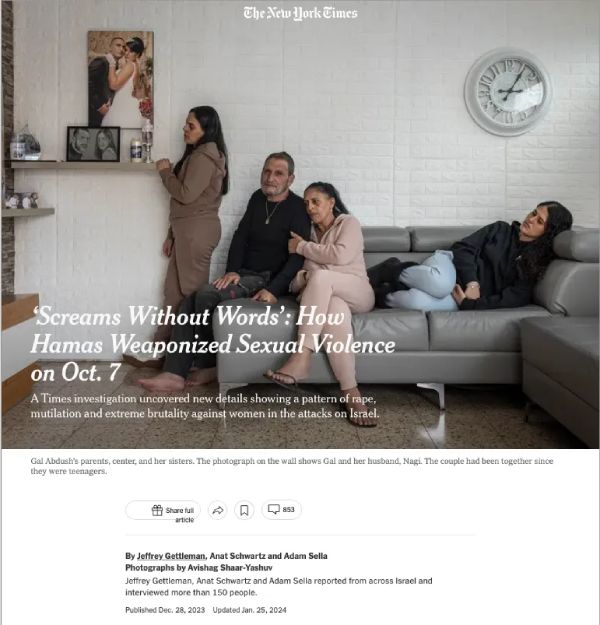
But the most damning criticism of the Times’ reporting came from the family of Gal Abdush, the headline victim in the “Screams without Words” story. Her parents and brother accused the New York Times of inventing the story that she had been raped at the Nova festival.
Moments before she was killed by a grenade, Abdush had messaged her family and made no mention of a rape or even a direct attack on her group. The family had heard no suggestion that rape was a factor in Abdush’s death.
A woman who had given the paper access to photos and video of Abdush taken that day said Schwartz had pressured her to do so on the grounds it would help “Israeli hasbara” – a term meaning propaganda designed to sway foreign audiences.
Schwartz cited the Israeli welfare ministry as claiming there were four survivors of sexual assault from 7 October, though no more details have been forthcoming from the ministry.
Back in early December, before the Times story, Israeli officials promised they had “gathered ‘tens of thousands’ of testimonies of sexual violence committed by Hamas”. None of those testimonies has materialised.
None ever will, according to Schwartz’s conversation with Channel 12. “There is nothing. There was no collection of evidence from the scene,” she said.
Nonetheless, Israeli officials continue to use the reports by the New York Times, the Guardian and others to try to bully major human rights bodies into agreeing that Hamas used sexual violence systematically.
Which may explain why the media eagerly seized on the chance to resurrect its threadbare narrative when UN official Pramila Patten, its special representative on sexual violence in conflict, echoed some of their discredited claims in a report published this month.
The media happily ignored the fact that Patten had no investigative mandate and that she heads what is in effect an advocacy group inside the UN. While Israel has obstructed UN bodies that do have such investigative powers, it welcomed Patten, presumably on the assumption that she would be more pliable.
In fact, she did little more than repeat the same unevidenced claims from Israel that formed the basis of the Times and Guardian’s discredited reporting.
Statements retracted
Even so, Patten included important caveats in the small print of her report that the media were keen to overlook.
At a press conference, she reiterated that she had seen no evidence of a pattern of behaviour by Hamas, or of the use of rape as a weapon of war – the very claims the Western media had been stressing for weeks.
She concluded in the report that she was unable to “establish the prevalence of sexual violence”. And further, she conceded it was not clear if any sexual violence occurring on 7 October was the responsibility of Hamas, or other groups or individuals.
All of that was ignored by the media. In typical fashion, a Guardian article on her report asserted wrongly in its headline: “UN finds ‘convincing information’ that Hamas raped and tortured Israeli hostages”.
Patten’s primary source of information, she conceded, were Israeli “national institutions” – state officials who had every incentive to mislead her in the furtherance of the country’s war aims, as they had earlier done with a compliant media.
As the US Jewish scholar Normal Finkelstein has pointed out, Patten also relied on open-source material: 5,000 photos and 50 hours of video footage from bodycams, dashcams, cellphones, CCTV and traffic surveillance cameras. And yet that visual evidence yielded not a single image of sexual violence. Or as Patten phrased it: “No tangible indications of rape could be identified.”
She admitted she had seen no forensic evidence of sexual violence, and had not met a single survivor of rape or sexual assault.
And she noted that the witnesses and sources her team spoke to – the same individuals the media had relied on – proved unreliable. They “adopted over time an increasingly cautious and circumspect approach regarding past accounts, including in some cases retracting statements made previously”.
Collusion in genocide
If anything has been found to be systematic, it is the failings in the Western media’s coverage of a plausible genocide unfolding in Gaza.
Last week a computational analysis of the New York Times’ reporting revealed it continued to focus heavily on Israeli perspectives, even as the death-toll ratio showed that 30 times as many Palestinians had been killed by Israel in Gaza than Hamas had killed Israelis on 7 October.
The paper quoted Israelis and Americans many times more regularly than they did Palestinians, and when Palestinians were referred to it was invariably in the passive voice.
In Britain, the Muslim Council of Britain’s Centre for Media Monitoring has analysed nearly 177,000 clips from TV broadcasts covering the first month after the 7 October attack. It found Israeli perspectives were three times more common than Palestinian ones.
A similar study by the Glasgow Media Group found that journalists regularly used condemnatory language for the killing of Israelis – “murderous”, “mass murder”, “brutal murder” and “merciless murder” – but never when Palestinians were being killed by Israel. “Massacres”, “atrocities” and “slaughter” were only ever carried out against Israelis, not against Palestinians.
Faced with a plausible case of genocide – one being televised for months on end – even the liberal elements of the Western media have shown they have no serious commitment to the liberal democratic values they are supposedly there to uphold.
They are not a watchdog on power, either the power of the Israeli military or Western states colluding in Israel’s slaughter. Rather the media are central to making the collusion possible. They are there to disguise and whitewash it, to make it look acceptable.
Indeed, the truth is that, without that help, Israel’s allies would long ago have been shamed into action, into stopping the slaughter and starvation. The Western media’s hands are stained in Gaza’s blood.
Author
Jonathan Cook is a recovering British corporate media journalist (formerly of the Guardian and Observer newspapers), and a winner of the Martha Gellhorn Special Prize for Journalism. He has been an independent journalist for more than 20 years. Much of that time, he covered the Israel-Palestine beat, where he witnessed first hand the establishment media’s role in perpetuating the suffering of people in the region by failing to hold Western politicians and policy-makers to account. Today, he writes widely on media, politics, corporate power and international affairs. He also occasionally ventures into analyses of the culture wars, science, health and philosophy.



